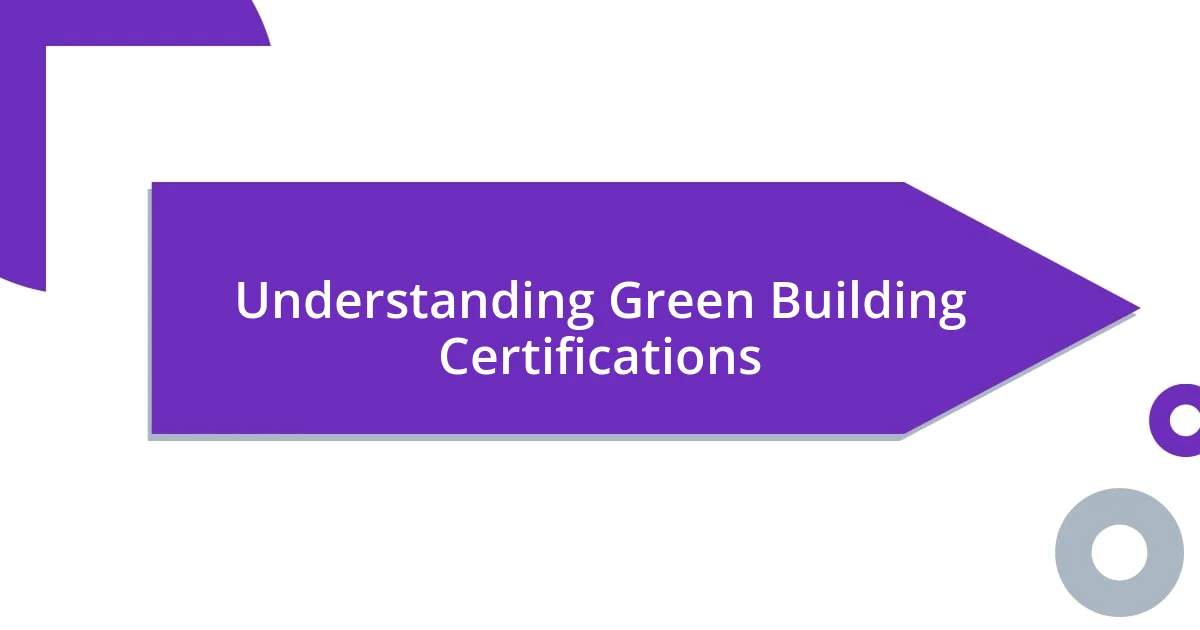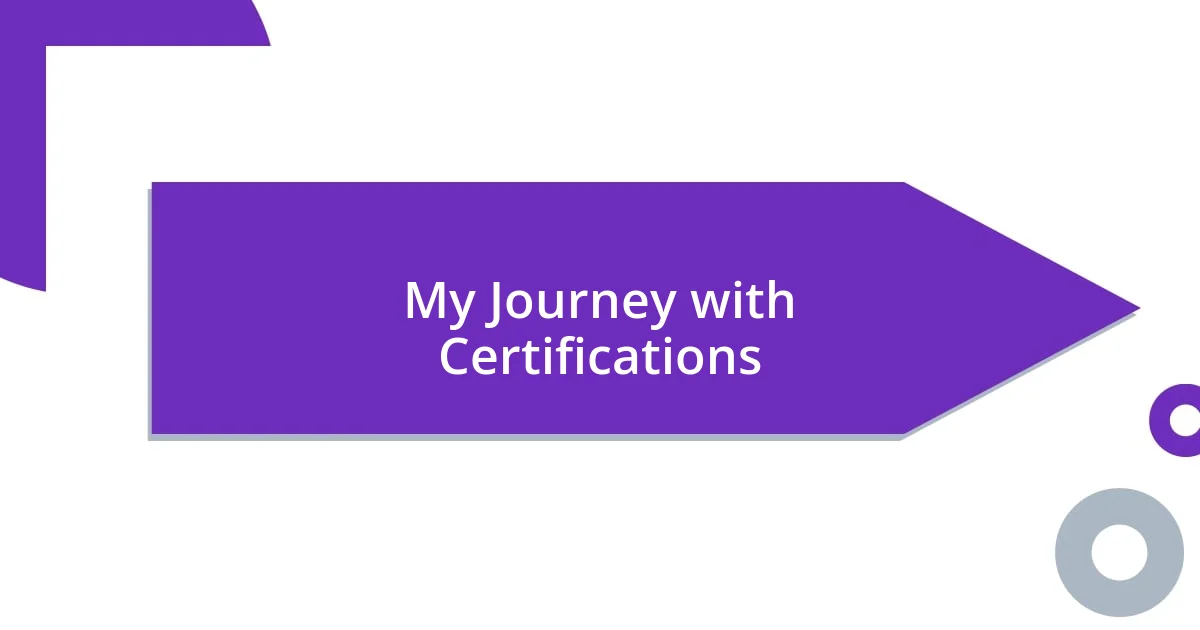Key takeaways:
- Green building certifications, like LEED and BREEAM, encompass energy efficiency, water conservation, and sustainable materials, driving both environmental and occupant health benefits.
- Achieving certifications leads to long-term advantages, including lower operating costs, increased property values, enhanced occupant comfort, and a positive impact on the environment.
- Successful navigation of the certification process relies on thorough understanding of requirements, organized documentation, collaboration among diverse teams, and early engagement with certifying bodies for guidance.

Understanding Green Building Certifications
Green building certifications serve as a valuable framework for promoting sustainable practices in construction and design. From my experience, navigating these certifications can feel overwhelming at first. I vividly remember sifting through heaps of guidelines and requirements, feeling a mix of excitement and anxiety about the potential impact on my projects.
What struck me was how these certifications, like LEED or BREEAM, not only emphasize energy efficiency but also address factors such as water conservation, sustainable materials, and indoor air quality. I still recall a project where we prioritized these elements, and the result was more than just a checklist—it fostered a sense of community and well-being among the occupants. Have you ever paused to think about how a building can contribute to your health?
As I delved deeper, I discovered that achieving certification can lead to tangible benefits beyond environmental impact, such as reduced operating costs and increased property values. It’s like opening a door to a new realm of possibilities. This journey isn’t just about meeting green standards; it’s about contributing to a sustainable future while reaping the rewards that come along with it.

Types of Green Building Certifications
Green building certifications come in various types, each with its unique focus and benefits. For instance, I’ve always found LEED (Leadership in Energy and Environmental Design) to be one of the most recognized certifications. It emphasizes energy efficiency, water conservation, and sustainable site development, and I can still remember the thrill of getting my first LEED Gold certification; it was a game-changer for my approach to sustainable design.
On the other hand, BREEAM (Building Research Establishment Environmental Assessment Method) takes a broader view, covering everything from management practices to material sourcing. I worked on a project that pursued BREEAM certification, and it required collaboration across multiple teams, which was both challenging and rewarding. The lessons I learned during the process taught me how crucial it is to engage everyone involved—not just the architects but also the contractors and investors—to truly embrace sustainable building practices.
Another certification worth mentioning is the Living Building Challenge, which is the strictest of the bunch, expecting buildings to achieve net-zero energy, water, and waste. I remember feeling both inspired and daunted by the ambitious goals of this certification. The commitment it demands reflects an ideal I strive toward in my own practice, reminding me of the profound impact our built environment can have on nature.
| Certification | Focus Areas |
|---|---|
| LEED | Energy efficiency, water conservation, indoor air quality |
| BREEAM | Comprehensive assessment from design to operational management |
| Living Building Challenge | Net-zero energy, water, and waste |

Benefits of Green Building Certifications
One of the standout benefits of pursuing green building certifications is the significant cost savings over time. I’ve seen firsthand how energy-efficient designs translate into lower utility bills. When we established a green roof at one of my projects, not only did the building’s aesthetic appeal soar, but we also noticed a remarkable reduction in heating and cooling expenses, which was a win for both the environment and our budget. The long-term financial advantages truly make the effort worthwhile.
Here are some specific benefits I’ve observed from green building certifications:
- Lower Operating Costs: Reduced energy and water consumption cuts down on monthly expenses.
- Increased Property Value: Properties that are certified often attract buyers and tenants willing to pay a premium for sustainable living.
- Enhanced Occupant Health and Comfort: Better indoor air quality and access to natural light lead to happier, healthier residents.
- Positive Environmental Impact: Certifications promote the use of renewable resources and sustainable materials, contributing to a healthier planet.
Reflecting on the impact of certification, I remember a project where we paid particular attention to indoor air quality. After certification, feedback from occupants was overwhelmingly positive; they felt more energized and productive. Witnessing that connection between a certified building and occupant satisfaction was deeply gratifying, reinforcing my belief in the importance of sustainable practices in construction.

My Journey with Certifications
The journey to obtaining my certifications was filled with excitement and a bit of anxiety. I vividly remember standing outside my first LEED accredited building, feeling a rush of pride wash over me as I reflected on the countless hours spent gathering documentation and collaborating with the team. I sometimes wonder if others feel the same mix of exhilaration and nervousness when working toward their goals—it’s a strange yet motivating cocktail of emotions.
Diving into BREEAM certification felt like opening Pandora’s box; there was so much to consider beyond just energy use. I often found myself engaged in deep discussions with contractors about material sourcing and waste management, which expanded my perspective. I realized that achieving these certifications isn’t just about ticking boxes; it’s about fostering a culture of sustainability among everyone involved. Have you ever had a moment where you realized that the journey is just as vital as the end goal? For me, each conversation was a stepping stone toward a more eco-conscious mindset for all.
The Living Building Challenge was both daunting and exhilarating, challenging my understanding of what truly sustainable building means. I once spent a sleepless night trying to figure out how we could achieve net-zero energy in design while still being mindful of client budgets. Reflecting on those sleepless nights, I feel they were moments of growth that shaped my current approach. Was it tough? Yes. But that struggle pushes me to continuously seek innovative solutions, and I’ve come to embrace that challenge as part of my journey.

Steps to Obtain a Certification
To obtain green building certifications, the first step is often a thorough understanding of the specific requirements. When I began this process, I remember pouring over the guidelines—literally marking up my printed copies with notes and questions. This initial research phase is crucial; it gave me clarity and set a solid foundation for the entire journey. Have you ever started something new and felt that rush of information overload? I’ve been there, and it’s completely normal!
Once you grasp the requirements, gathering necessary documentation becomes the next logical step. I recall spending an entire weekend organizing project details, from energy bills to material specifications, into neat folders. It might feel tedious, but this phase is where you begin to see the tangible benefits of planning and record-keeping. I often say that good organization is like a backbone for your certification process; without it, things can quickly turn chaotic.
Finally, collaboration with a diverse team is key to successfully navigating the certification process. During one of my projects, I worked closely with architects, engineers, and contractors to ensure everyone was aligned on sustainable practices. The honesty and open dialogue we maintained really fostered a creative atmosphere, allowing us to tackle challenges together. Isn’t it fascinating how teamwork can transform what might seem like a daunting task into a shared goal? I can’t stress enough the importance of involving all stakeholders—it’s truly a game-changer for achieving that coveted certification.

Challenges Faced During Certification
Navigating the certification process often felt like trying to solve a complex puzzle. I remember one particular instance where I miscalculated our energy performance due to outdated software. The sheer frustration I experienced in having to go back and re-evaluate our numbers was disheartening, but it reinforced the importance of using up-to-date tools. Have you ever faced a setback that later turned out to be a valuable lesson? I certainly have.
Another challenge I encountered was the varying levels of commitment within the project team. On one project, I found myself pushing hard for sustainable practices while a few team members were resistant to change. This disparity led to tense discussions, yet it also gestured toward a critical moment of advocacy. I realized that understanding different perspectives not only builds character but strengthens resolve. What’s the point of a certification if it’s not embraced by everyone involved? Ultimately, these interactions taught me the importance of patience and the need for clear communication to align our goals.
Lastly, the timeline pressures can really add stress to the certification process. I distinctly recall one tight deadline when we had just a few weeks left to submit our documentation for LEED certification. The late nights and early mornings blurred together as I rushed to ensure everything was in place. While it tested my resilience, it also brought about a sense of urgency that ignited my creativity. Doesn’t it sometimes feel like pressure can lead to breakthroughs? In my experience, navigating these challenges pushed me to think outside the box and adapt more quickly than I ever thought possible.

Tips for Successful Certification Process
The first tip I would share from my journey is to stay organized from the very beginning. I recall a project where I utilized a project management tool that allowed me to track every document related to our certification efforts in real-time. Not only did this change how I managed tasks, but it also reduced stress by providing a clear overview of what needed to be done and when. Have you ever found peace of mind by simply having everything in one place? It truly makes a difference and can streamline the entire process.
Another essential aspect is to remain adaptable throughout the certification journey. There were times when I had to pivot quickly due to changes in regulations or unexpected challenges. For instance, during one project, we had to switch some materials last minute to comply with newer standards. Instead of feeling overwhelmed, I embraced these shifts as opportunities for innovation. Isn’t it intriguing how flexibility can lead us to discover new solutions we hadn’t considered before? I found that maintaining an open mindset not only alleviated tension but helped foster a culture of creativity in our team.
Lastly, never underestimate the power of early engagement with certification bodies. I remember a particularly enlightening conversation with a LEED representative early in the process of one project. Their insights tailored my approach significantly and saved me a lot of backtracking later on. It reminded me of the importance of seeking guidance proactively rather than waiting until issues arise. Have you ever reached out for help only to find it opens up a wealth of knowledge? Engaging with certifying agencies early on can lay a solid groundwork for success—and it’s a step I highly recommend.














